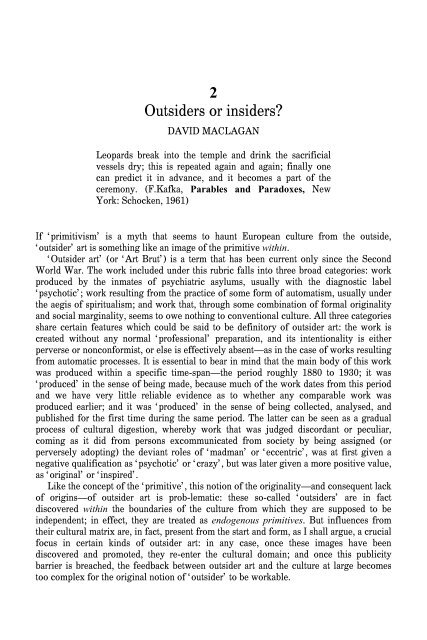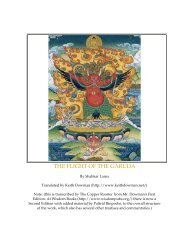Hiller - The Myth of Primitivism. Perspectives on Art - Esoteric Online
Hiller - The Myth of Primitivism. Perspectives on Art - Esoteric Online
Hiller - The Myth of Primitivism. Perspectives on Art - Esoteric Online
Create successful ePaper yourself
Turn your PDF publications into a flip-book with our unique Google optimized e-Paper software.
2<br />
Outsiders or insiders?<br />
DAVID MACLAGAN<br />
Leopards break into the temple and drink the sacrificial<br />
vessels dry; this is repeated again and again; finally <strong>on</strong>e<br />
can predict it in advance, and it becomes a part <str<strong>on</strong>g>of</str<strong>on</strong>g> the<br />
cerem<strong>on</strong>y. (F.Kafka, Parables and Paradoxes, New<br />
York: Schocken, 1961)<br />
If ‘primitivism’ is a myth that seems to haunt European culture from the outside,<br />
‘outsider’ art is something like an image <str<strong>on</strong>g>of</str<strong>on</strong>g> the primitive within.<br />
‘Outsider art’ (or ‘<strong>Art</strong> Brut’) is a term that has been current <strong>on</strong>ly since the Sec<strong>on</strong>d<br />
World War. <str<strong>on</strong>g>The</str<strong>on</strong>g> work included under this rubric falls into three broad categories: work<br />
produced by the inmates <str<strong>on</strong>g>of</str<strong>on</strong>g> psychiatric asylums, usually with the diagnostic label<br />
‘psychotic’; work resulting from the practice <str<strong>on</strong>g>of</str<strong>on</strong>g> some form <str<strong>on</strong>g>of</str<strong>on</strong>g> automatism, usually under<br />
the aegis <str<strong>on</strong>g>of</str<strong>on</strong>g> spiritualism; and work that, through some combinati<strong>on</strong> <str<strong>on</strong>g>of</str<strong>on</strong>g> formal originality<br />
and social marginality, seems to owe nothing to c<strong>on</strong>venti<strong>on</strong>al culture. All three categories<br />
share certain features which could be said to be definitory <str<strong>on</strong>g>of</str<strong>on</strong>g> outsider art: the work is<br />
created without any normal ‘pr<str<strong>on</strong>g>of</str<strong>on</strong>g>essi<strong>on</strong>al’ preparati<strong>on</strong>, and its intenti<strong>on</strong>ality is either<br />
perverse or n<strong>on</strong>c<strong>on</strong>formist, or else is effectively absent—as in the case <str<strong>on</strong>g>of</str<strong>on</strong>g> works resulting<br />
from automatic processes. It is essential to bear in mind that the main body <str<strong>on</strong>g>of</str<strong>on</strong>g> this work<br />
was produced within a specific time-span—the period roughly 1880 to 1930; it was<br />
‘produced’ in the sense <str<strong>on</strong>g>of</str<strong>on</strong>g> being made, because much <str<strong>on</strong>g>of</str<strong>on</strong>g> the work dates from this period<br />
and we have very little reliable evidence as to whether any comparable work was<br />
produced earlier; and it was ‘produced’ in the sense <str<strong>on</strong>g>of</str<strong>on</strong>g> being collected, analysed, and<br />
published for the first time during the same period. <str<strong>on</strong>g>The</str<strong>on</strong>g> latter can be seen as a gradual<br />
process <str<strong>on</strong>g>of</str<strong>on</strong>g> cultural digesti<strong>on</strong>, whereby work that was judged discordant or peculiar,<br />
coming as it did from pers<strong>on</strong>s excommunicated from society by being assigned (or<br />
perversely adopting) the deviant roles <str<strong>on</strong>g>of</str<strong>on</strong>g> ‘madman’ or ‘eccentric’, was at first given a<br />
negative qualificati<strong>on</strong> as ‘psychotic’ or ‘crazy’, but was later given a more positive value,<br />
as ‘original’ or ‘inspired’.<br />
Like the c<strong>on</strong>cept <str<strong>on</strong>g>of</str<strong>on</strong>g> the ‘primitive’, this noti<strong>on</strong> <str<strong>on</strong>g>of</str<strong>on</strong>g> the originality—and c<strong>on</strong>sequent lack<br />
<str<strong>on</strong>g>of</str<strong>on</strong>g> origins—<str<strong>on</strong>g>of</str<strong>on</strong>g> outsider art is prob-lematic: these so-called ‘outsiders’ are in fact<br />
discovered within the boundaries <str<strong>on</strong>g>of</str<strong>on</strong>g> the culture from which they are supposed to be<br />
independent; in effect, they are treated as endogenous primitives. But influences from<br />
their cultural matrix are, in fact, present from the start and form, as I shall argue, a crucial<br />
focus in certain kinds <str<strong>on</strong>g>of</str<strong>on</strong>g> outsider art: in any case, <strong>on</strong>ce these images have been<br />
discovered and promoted, they re-enter the cultural domain; and <strong>on</strong>ce this publicity<br />
barrier is breached, the feedback between outsider art and the culture at large becomes<br />
too complex for the original noti<strong>on</strong> <str<strong>on</strong>g>of</str<strong>on</strong>g> ‘outsider’ to be workable.




